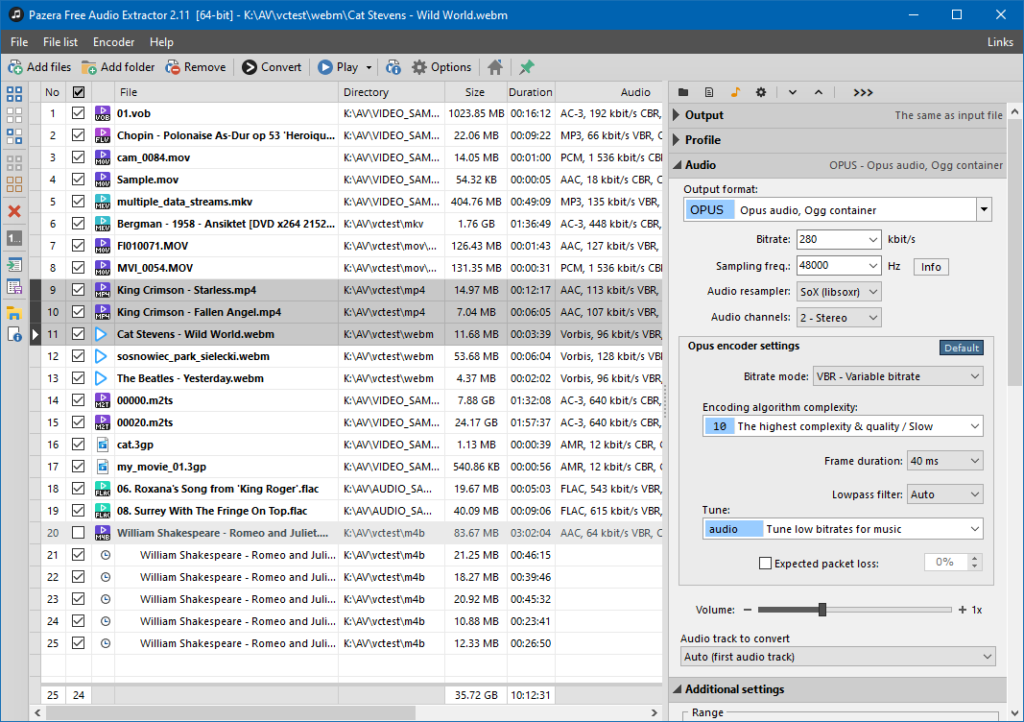

VBR Mode: Small Portable, High Quality Portable, Normal, High, ExtremeĪpproximate bitrates achieved by the above settings are shown here:.Select from the following modes to set quality, bitrate, or any custom command line switches. By default, Media Center is set to encode in VBR/Normal format. MP3 Encoder: Popular, lossy encoder based on the LAME MP3 Encoder.The High setting only saves about 6MB of space over an entire CD. The last two compress the file the most, but the file will also be slower to decompress and play. Compression Level: Fast, Normal (Recommended), High, and Extra High.Monkey's Audio (APE): Monkey's Audio is a fast lossless encoder, supporting all sample frequencies.Use Ogg as transport layer (*.ogg): FLAC streams wrapped in an Ogg transport layer - leave disabled unless you have reason to enable.Add seek table (if possible): Allows seeking within FLAC files to perform better.Add 4k padding block: Adds space within the file so minor meta-data additions don't require rewriting entire FLAC file.
 Verify encoding: Validates encoding (TBD: does this work?). Sets the level of compression (not sound, which is always lossless), 8 meaning most compressed/time/effort.
Verify encoding: Validates encoding (TBD: does this work?). Sets the level of compression (not sound, which is always lossless), 8 meaning most compressed/time/effort. Freac ogg quality settings free#
Free Lossless Audio Codec (FLAC): FLAC is a popular lossless, freely available open source encoder. If the encoder supports long file names, check the box. Select this and enter the EXE path and parameters. External Encoder: Allows using external encoders such as Xing, Blade, Lame, Gogo, ALAC, etc. If you are using an older version, encoder versions are found here ]. Note: There have been no new encoder versions posted to the plug-ins site since Media Center 12. Note: Some encoders (OGG, MP3, and MPC) are automatically downloaded on first use. The listed encoders are installed in Media Center by default, and recent versions of Media Center include the most popular encoders. Configure the profile before performing any of the following tasks: Note the -application voip setting that I used above and which does not have an equivalent with opusenc (unlike the other settings).Three separate encoding profiles may be configured using the drop-down selectors below. Speech encoding quality: The definitive HydrogenAudio page to guide Opus settings for speech.ġ5.8 libopus: FFmpeg options for use with libopus encoding. Sample Rates: A nice page from the Audacity developers that demonstrates the best settings for audio sample rates. I have included a link to a great HydrogenAudio resource in the 'References' which should guide to an even better command line for Opus. You will be pleasantly surprised by both the resulting output file size and audio quality. c:a libopus -b:a 16k -ar 16000 -ac 1 -application voip \ Try something like the following which has been tailored for your speech files: ffmpeg -i filename.ogg \ If you are perhaps not all that set on using Ogg Vorbis an excellent alternative is to use Opus, which in my tests shaved a reasonable number of kilobytes off each file in comparison to the Ogg Vorbis 32k encode. Use FFmpeg to create a small file using libopus. With this in mind my own testing suggests that you would be best to use a sampling rate of 22050 Hz, note that this should be perfectly adequate for speech, and thus your command line should be: ffmpeg -i filename.ogg -c:a libvorbis -ab 32k -ar 22050 new-filename.oggĪnd this produced a quite reasonable outcome on my own setup.Ģ. 8000 Hz: Slightly lower sampling rate than a modern telephony system, not recommended for most recording tasks. 22050 Hz: Adequate for speech and usable for other audio with the expectation that there will be audio quality loss.  32000 Hz: Adequate for speech and also adequate for other audio files where a smaller file size is required with an expected small loss of quality. 44100 Hz: Typical Audio CD sample rate. So you have a choice to make for the best sampling rate for your 32k Ogg Vorbis audio. But then FFmpeg usually does not do a lot of hand holding I guess!īear in mind that an Audio CD will normally have a sampling rate of 44100 Hz while simple telephony would normally have a sampling rate of slightly greater than 8000 Hz. The key issue is that FFmpeg will not automagically change the audio sampling rate to appropriately match your selected bitrate.
32000 Hz: Adequate for speech and also adequate for other audio files where a smaller file size is required with an expected small loss of quality. 44100 Hz: Typical Audio CD sample rate. So you have a choice to make for the best sampling rate for your 32k Ogg Vorbis audio. But then FFmpeg usually does not do a lot of hand holding I guess!īear in mind that an Audio CD will normally have a sampling rate of 44100 Hz while simple telephony would normally have a sampling rate of slightly greater than 8000 Hz. The key issue is that FFmpeg will not automagically change the audio sampling rate to appropriately match your selected bitrate. 
Use FFmpeg to create a small file using libopus.Adjust your FFmpeg command line to produce a smaller Ogg Vorbis file.








 0 kommentar(er)
0 kommentar(er)
